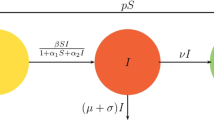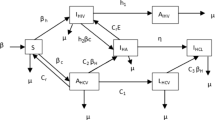Abstract
The Covid-19 virus group is one of the most groups of viruses that influenced the life of mankind in the past twenty years. A review of previous models was presented. In this work, we fill the gap in the literature by proposing a discrete-time epidemic model by applying the backward difference scheme to the Omicron variant. In this paper, the authors modeled the spread of Covid-19 mutation variants data from South Africa. This work uses a mathematical model SEAIOH to describe Covid-19 Omicron spreading. Moreover, the analysis of the proposed model is proven for both local and global stability. Thus, the numerical and discussion results align with the analysis theory. According to the proposed model, the dynamical behavior analysis of nodes at each compartment helps to find relations between pandemic and endemic cases. This leads to set protection rules and decreases the number of infected individuals. Furthermore, our results might contribute to public health policy improvements to prevent the spread of the disease.












Similar content being viewed by others
Data Availability Statement
No Data associated in the manuscript.
References
J. Khan, K. Mclntosh, History and recent advances in coronavirus discovery. Pediatr. Infect. Dis. J. 24, 16378050 (2005)
World, Statement on the first meeting of the international health regulations (2005) emergency committee regarding the outbreak of novel coronavirus (2019-ncov), Jan (2020)
Z. Zhu, X. Lian, X. Su, W. Wu, G.A. Marraro, Y. Zeng, From SARS and MERS to covid-19: a brief summary and comparison of severe acute respiratory infections caused by three highly pathogenic human coronaviruses. Respirat. Res. 21(1), 1–14 (2020)
Tracking sars-cov-2 variants. https://www.who.int/en/activities/tracking-SARS-CoV-2-variants/. (Accessed on 06/14/2023)
T. Davenport, Big data at work: dispelling the myths, uncovering the opportunities (Harvard Business Review Press, New York City, 2014)
K.K. Singh, S. Kumar, P. Dixit, M.K. Bajpai, Kalman filter based short term prediction model for covid-19 spread. Appl. Intell. 51(5), 2714–2726 (2021)
C. Nowzari, V.M. Preciado, G.J. Pappas, Analysis and control of epidemics: a survey of spreading processes on complex networks. IEEE Contr. Syst. Magaz. 36(1), 26–46 (2016)
M. Al-arydah, H. Berhe, K. Dib, K. Madhu, Mathematical modeling of the spread of the coronavirus under strict social restrictions. Math. Meth. Appl. Sci. (2021). https://doi.org/10.1002/mma.7965
H. Alrabaiah, M.A. Safi, M.H. DarAssi, B. Al-Hdaibat, S. Ullah, M.A. Khan, S.A.A. Shah, Optimal control analysis of hepatitis b virus with treatment and vaccination. Results Phys. 19, 103599 (2020)
C.T. Bauch, J.O. Lloyd-Smith, M.P. Coffee, A.P. Galvani, Dynamically modeling SARS and other newly emerging respiratory illnesses: past, present, and future. Epidemiology 16(6), 791–801 (2005)
Y. Bechah, C. Capo, J.-L. Mege, D. Raoult, Epidemic typhus. Lancet Infect. Dis. 8(7), 417–426 (2008)
M.H. DarAssi, M.A. Safi, B. Al-Hdaibat, A delayed SEIR epidemic model with pulse vaccination and treatment. Nonlinear Stud. 25(3), 521–534 (2018)
M.H. DarAssi, M.A. Safi, M. Ahmad, Global dynamics of a discrete-time MERS-COV model. Mathematics 9(5), 563 (2021)
M. DarAssi, M. Safi, Analysis of an sirs epidemic model for a disease geographic spread. Nonlinear Dynam. Syst. Theory 21(1), 56–67 (2021)
M.H. DarAssi, M.A. Safi, M.A. Khan, A. Beigi, A.A. Aly, M.Y. Alshahrani, A mathematical model for SARS-COV-2 in variable-order fractional derivative. Eur. Phys. J. Special Topics (2022). https://doi.org/10.1140/epjs/s11734-022-00458-0
M.H. DarAssi, T.A. Shatnawi, M.A. Safi, Mathematical analysis of a MERS-COV coronavirus model. Demonst. Math. 55(1), 265–276 (2022)
O. Diekmann, J.A.P. Heesterbeek, Mathematical epidemiology of infectious diseases: model building, analysis and interpretation, vol. 5 (Wiley, Hobroken, 2000)
M. Altaf Khan, K. Khan, M.A. Safi, M.H. DarAssi, A discrete model of tb dynamics in khyber pakhtunkhwa-pakistan. Comput. Model Eng. Sci. 123(2), 777–795 (2020)
J.D. Murray, Mathematical biology: I An introduction (Springer, Berlin, 2002)
M.A. Safi, M.H. DarAssi, Mathematical analysis of a model for ectoparasite-borne diseases. Math. Meth. Appl. Sci. 41(17), 8248–8257 (2018)
M.A. Safi, M.H. DarAssi, Mathematical analysis of an age-structured HSV-2 model. J. Comput. Meth. Sci. Eng. 19(3), 841–856 (2019)
M.A. Safi, B. Al-Hdaibat, M.H. DarAssi, M.A. Khan, Global dynamics for a discrete quarantine/isolation model. Results Phys. 21, 103788 (2021)
A. Nutini, J. Zhang, A. Sohail, R. Arif, T.A. Nofal, Forecasting of the efficiency of monoclonal therapy in the treatment of covid-19 induced by the omicron variant of sars-cov2. Results Phys. 35, 105300 (2022)
T. Li, Y. Guo, Optimal control and cost-effectiveness analysis of a new covid-19 model for omicron strain. Physica A: Stat. Mech. Appl. 606, 128134 (2022)
T. Hussein, M.H. Hammad, O. Surakhi, M. AlKhanafseh, P.L. Fung, M.A. Zaidan, D. Wraith, N. Ershaidat, Short-term and long-term covid-19 pandemic forecasting revisited with the emergence of omicron variant in Jordan. Vaccines 10(4), 569 (2022)
M.A. Khan, A. Atangana, Modeling the dynamics of novel coronavirus (2019-NCOV) with fractional derivative. Alexandria Eng. J. 59(4), 2379–2389 (2020)
A. Hassan, D. Prasad, S. Rani, M. Alhassan, Gauging the impact of artificial intelligence and mathematical modeling in response to the covid-19 pandemic: a systematic review. BioMed Res. Int. (2022). https://doi.org/10.1155/2022/7731618
X.-P. Li, M.H. DarAssi, M.A. Khan, C. Chukwu, M.Y. Alshahrani, M.A. Shahrani, M.B. Riaz, Assessing the potential impact of covid-19 omicron variant: insight through a fractional piecewise model. Results Phys. 38, 105652 (2022)
B.-G. Wang, Z.-C. Wang, Y. Wu, Y. Xiong, J. Zhang, Z. Ma, A mathematical model reveals the influence of npis and vaccination on sars-cov-2 omicron variant, Nonlinear Dynamics, pp. 1–16, (2022)
C. Xu, M. Farman, A. Hasan, A. Akgül, M. Zakarya, W. Albalawi, C. Park, Lyapunov stability and wave analysis of covid-19 omicron variant of real data with fractional operator. Alexandria Eng. J. 61(12), 11787–11802 (2022)
M. Cai, G. Em Karniadakis, C. Li, Fractional SEIR model and data-driven predictions of covid-19 dynamics of omicron variant. Chaos Interdisc. J. Nonlin. Sci. 32(7), 071101 (2022)
J. A. Al-Tawfiq, V.-T. Hoang, N. Le Bui, D.-T. Chu, Z. A. Memish, The emergence of the omicron (b. 1.1. 529) sars-cov-2 variant: what is the impact on the continued pandemic? (2022)
R. U. Khan, A. U. Haq, S. M. Hussain, S. Ullah, S. Almakdi, R. Kumar, H. H. Shah, J. Li, Analyzing and battling the emerging variants of covid-19 using artificial neural network and blockchain, In: 2021 18th International computer conference on wavelet active media technology and information processing (ICCWAMTIP), pp. 101–105, IEEE (2021)
M.T. Sofonea, B. Roquebert, V. Foulongne, D. Morquin, L. Verdurme, S. Trombert-Paolantoni, M. Roussel, J.-C. Bonetti, J. Zerah, S. Haim-Boukobza et al., Analyzing and modeling the spread of sars-cov-2 omicron lineages ba. 1 and ba. 2, France, September 2021-February 2022. Emerg. Infect. Dis. 28(7), 1355 (2022)
C. Chen, X. Zijie, X. Yonghui, R. Tiong, Ensuring sufficient cabin hospital beds for curbing the spread of covid-19-findings from petri net analysis. Heliyon (2022). https://doi.org/10.1016/j.heliyon.2022.e11202
K. M. Alakkari, P. Mishra, D. Rawat, M. Abotaleb, A. M. Ghazi, Using ETS state space model for forecasting on third wave on covid19 in India (2022)
D. Ghosh, P. Santra, G. Mahapatra, A. Elsonbaty, A. Elsadany, A discrete-time epidemic model for the analysis of transmission of covid19 based upon data of epidemiological parameters. Eur. Phys. J. Special Topics (2022). https://doi.org/10.1140/epjs/s11734-022-00537-2
A. Tomar, N. Gupta, Prediction for the spread of covid-19 in India and effectiveness of preventive measures. Sci. Total Environ. 728, 138762 (2020)
Y. Zheng, Y. Wang, Transmission characteristics and predictive model for recent epidemic waves of covid-19 associated with omicron variant in major cities in China. Int. J. Public Health (2022). https://doi.org/10.3389/ijph.2022.1605177
Q. Deng 2022 Modeling the omicron dynamics and development in china: with a deep learning enhanced compartmental model, medRxiv, pp. 2022–06 (2022)
R. Browning, D. Sulem, K. Mengersen, V. Rivoirard, J. Rousseau, Simple discrete-time self-exciting models can describe complex dynamic processes: a case study of covid-19. PloS one 16(4), e0250015 (2021)
L.E. Brandao, J.S. Dyer, Decision analysis and real options: a discrete time approach to real option valuation. Annals Operat Res 135, 21–39 (2005)
R.M. Anderson, R.M. May, Population biology of infectious diseases: part i. Nature 280(5721), 361–367 (1979)
O. Diekmann, J.A.P. Heesterbeek, J.A. Metz, On the definition and the computation of the basic reproduction ratio r0 in models for infectious diseases in heterogeneous populations. J. Math. Biol. 28(4), 365–382 (1990)
P. Van den Driessche, J. Watmough, Reproduction numbers and sub-threshold endemic equilibria for compartmental models of disease transmission. Math. Biosci. 180(1–2), 29–48 (2002)
H.W. Hethcote, The mathematics of infectious diseases. SIAM Rev. 42(4), 599–653 (2000)
J. LaSalle, “The stability of dynamical systems, society for industrial and applied mathematics, philadelphia, pa., 1976,” in With an appendix:“Limiting equations and stability of nonautonomous ordinary differential equations” by Z. Artstein, Regional Conference Series in Applied Mathematics, (1976)
Share of SARS-CoV-2 sequences that are the omicron variant.
A. Muniyappan, B. Sundarappan, P. Manoharan, M. Hamdi, K. Raahemifar, S. Bourouis, V. Varadarajan, Stability and numerical solutions of second wave mathematical modeling on covid-19 and omicron outbreak strategy of pandemic: Analytical and error analysis of approximate series solutions by using hpm. Mathematics 10(3), 343 (2022)
Open government data (ogd) platform india or data.gov.in (2020)
Coronavirus disease 2019 (covid-19): who situation report (2020), (2020)
Dedicated covid facilities status-333 (2023)
Stopcoronatn - health & family welfare department, government of Tamilnadu (2023)
S. Mallakpour, E. Azadi, C. M. Hussain, Fabrication of air filters with advanced filtration performance for removal of viral aerosols and control the spread of covid-19, Advances in Colloid and Interface Science, p. 102653, (2022)
J.T. Brooks, J.C. Butler, Effectiveness of mask wearing to control community spread of SARS-COV-2. Jama 325(10), 998–999 (2021)
Author information
Authors and Affiliations
Corresponding author
Rights and permissions
Springer Nature or its licensor (e.g. a society or other partner) holds exclusive rights to this article under a publishing agreement with the author(s) or other rightsholder(s); author self-archiving of the accepted manuscript version of this article is solely governed by the terms of such publishing agreement and applicable law.
About this article
Cite this article
DarAssi, M.H., Damrah, S. & AbuHour, Y. A mathematical study of the omicron variant in a discrete-time Covid-19 model. Eur. Phys. J. Plus 138, 601 (2023). https://doi.org/10.1140/epjp/s13360-023-04233-5
Received:
Accepted:
Published:
DOI: https://doi.org/10.1140/epjp/s13360-023-04233-5




